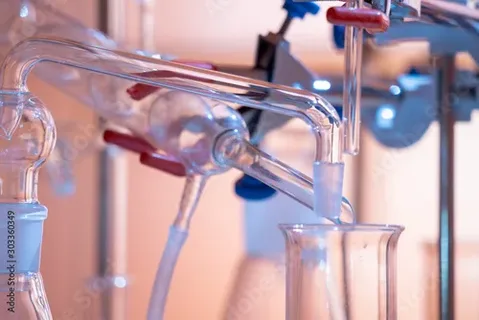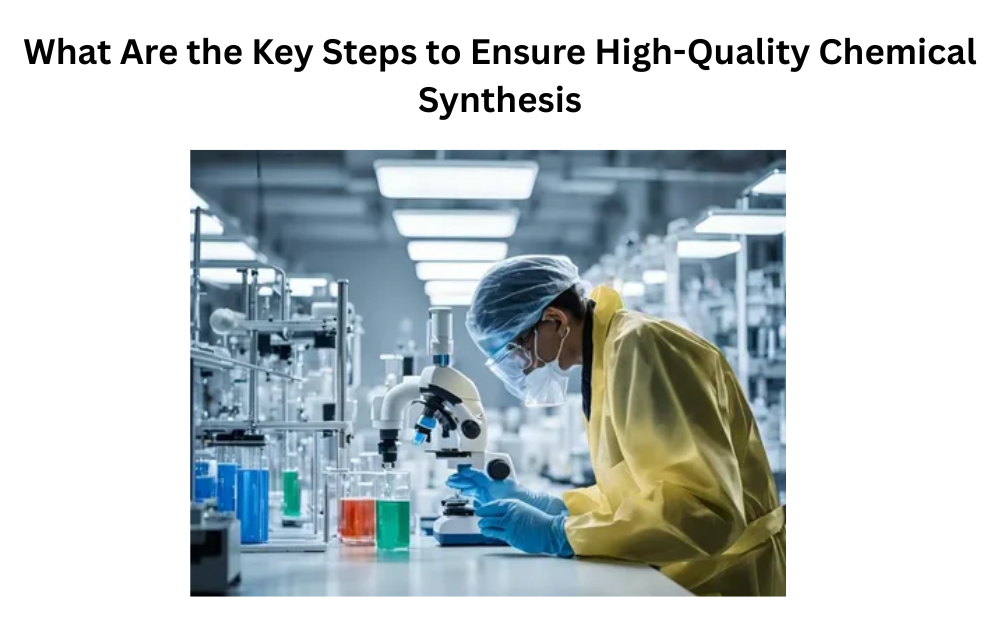Chemical synthesis is the foundation of modern chemistry and pharmaceutical industries. It involves creating complex chemical compounds from simpler substances through controlled reactions. The quality of chemical synthesis plays a major role in the success of industries such as pharmaceuticals, biotechnology, agriculture, and materials science.
High-quality chemical synthesis ensures that the final product is pure, effective, safe, and consistent. It also minimizes waste, reduces costs, and supports regulatory compliance. In this article, we will explain the key steps involved in achieving high-quality chemical synthesis in a simple and easy-to-understand way.
Understanding High-Quality Chemical Synthesis

Before diving into the steps, it’s important to understand what high-quality chemical synthesis means.
High-quality chemical synthesis is not just about making a chemical; it is about making it accurately, safely, and consistently. The product must meet strict purity standards, and the process must be reproducible. High-quality synthesis also ensures that the final compound is free from unwanted impurities or byproducts.
This is especially important in pharmaceuticals, where even small amounts of impurities can affect the safety and effectiveness of a drug.
Step 1: Planning and Designing the Synthesis
The first step in high-quality chemical synthesis is proper planning. Without a clear plan, the reaction may fail or produce inconsistent results.
Importance of Planning
Planning involves understanding the chemical you want to produce, selecting the best pathway, and predicting possible challenges. It includes:
- Identifying the desired compound
- Choosing the most efficient synthetic route
- Estimating costs, time, and resources
Designing a Synthetic Pathway
There are often multiple ways to create the same chemical. Choosing the right pathway involves minimizing unwanted byproducts, using safe reagents, and maximizing yield. This is like creating a roadmap before starting a journey—it ensures that every step is clear and manageable.
Step 2: Selecting High-Quality Raw Materials
The quality of raw materials directly impacts the final product. Suppliers must provide verified and pure chemicals to ensure successful synthesis.
Why Material Selection Matters
Impurities in starting materials can lead to contamination in the final product. Selecting high-quality, certified raw materials reduces risks and ensures better results.
Material Verification
Each batch of raw material should be tested for purity and consistency before use. This step ensures traceability and reliability, which are crucial for high-quality synthesis.
Step 3: Setting Up Controlled Reactions
Once the materials are ready, the reaction must be carried out in a controlled environment.
Laboratory Setup
Chemical synthesis requires specialized equipment such as flasks, reactors, heating devices, and stirrers. These tools help maintain precise reaction conditions.
Controlling Reaction Conditions
High-quality synthesis requires careful control of:
- Temperature
- Pressure
- Reaction time
- Solvent choice
Controlling these factors ensures that the reaction proceeds efficiently and produces the desired compound with minimal byproducts.
Step 4: Conducting the Reaction
This step involves combining the chemicals according to the planned procedure.
Monitoring the Reaction
Continuous monitoring is crucial. Scientists observe changes such as:
- Color changes
- Gas evolution
- Precipitation
- Heat release
Advanced instruments, like digital sensors and automated analyzers, help detect deviations early and allow for adjustments to maintain quality.
Safety Measures
Chemical reactions can be hazardous. Wearing protective equipment, using fume hoods, and following safety protocols are essential to prevent accidents.
Step 5: Isolation of the Desired Product
After the reaction is complete, the desired compound must be separated from the mixture of other chemicals.
Common Isolation Techniques
- Filtration: Separates solids from liquids
- Distillation: Separates liquids based on boiling points
- Extraction: Uses solvents to pull out the target compound
Isolation ensures that only the desired compound is collected for further processing.
Step 6: Purification of the Compound
Even after isolation, the compound may contain traces of impurities. Purification is necessary to achieve high-quality chemical synthesis.
Purification Methods
- Recrystallization: Forms pure crystals from a solution
- Chromatography: Separates compounds based on their chemical properties
- Washing: Removes unwanted soluble impurities
Purification is repeated until the product meets strict quality standards, especially for pharmaceutical or sensitive applications.
Step 7: Analytical Testing and Verification
Testing the compound is crucial to confirm its identity, purity, and quality.
Analytical Techniques
- Spectroscopy (NMR, IR, UV): Analyzes molecular structure and detects impurities
- Chromatography (HPLC, GC): Measures purity and quantifies trace compounds
- Mass Spectrometry: Confirms molecular weight and identity
- Melting Point Analysis: Checks physical properties to match specifications
High-quality synthesis relies on precise and thorough analytical testing.
Step 8: Documentation and Traceability
Accurate documentation is essential for maintaining quality and regulatory compliance.
Why Documentation Matters
Every batch of chemicals should have a record of:
- Raw materials used
- Reaction conditions
- Purification processes
- Analytical test results
Traceability allows suppliers and manufacturers to identify the source of any issues and maintain consistent quality.
Step 9: Compliance with Standards and Regulations
High-quality chemical synthesis must follow local and international regulations.
Regulatory Standards
- GMP (Good Manufacturing Practices): Ensures consistent, controlled production
- ISO Certification: Confirms quality management systems
- Safety and Environmental Compliance: Protects workers and the environment
Compliance demonstrates reliability and reduces risks for manufacturers and end-users.
Step 10: Scaling Up from Lab to Industry
After successful small-scale synthesis, industries often need to produce larger quantities. Scaling up requires careful control to maintain quality.
Challenges of Scaling Up
- Maintaining purity at higher volumes
- Controlling costs
- Managing safety and environmental risks
Industrial-scale synthesis uses larger reactors, automated monitoring, and strict protocols to replicate lab results on a larger scale.
Step 11: Continuous Improvement and Innovation
High-quality chemical synthesis is not a one-time process. Suppliers continually improve their methods to enhance yield, purity, and safety.
How Continuous Improvement Helps
- Reduces waste and costs
- Minimizes environmental impact
- Keeps up with regulatory changes
- Introduces innovative solutions for complex compounds
Suppliers who invest in research and development provide better support for pharmaceutical and industrial clients.
Benefits of High-Quality Chemical Synthesis
Partnering with experts who follow these steps brings multiple benefits:
- Consistency: Every batch meets required specifications
- Safety: Reduces risks to workers and consumers
- Regulatory Compliance: Avoids legal or regulatory issues
- Efficiency: Improves yield and reduces waste
- Innovation Support: Reliable synthesis helps R&D efforts
High-quality synthesis is essential for success in industries that depend on chemicals.
Final Thoughts
Ensuring high-quality chemical synthesis involves careful planning, high-quality materials, controlled reactions, purification, thorough testing, documentation, compliance, and continuous improvement. Each step is critical to producing a safe, effective, and reliable chemical product.
By following these key steps, chemical suppliers and manufacturers can achieve consistent results, support innovation, and maintain trust with clients and regulatory authorities. Whether in pharmaceuticals, materials science, or biotechnology, high-quality chemical synthesis is the backbone of successful industrial and research operations.
PureSynth Research Chemicals are a global solution provider and thrive to push the frontiers of chemistry. Don’t be limited by synthetic accessibility. Turn your imagination into reality and make the molecule you should, not the one you could. Our chemical expertise gives you access to a virtually infinite chemical space, helping you grasp the full potential of your ideas.
For more insightful articles related to this topic, feel free to visit: writoka.com



